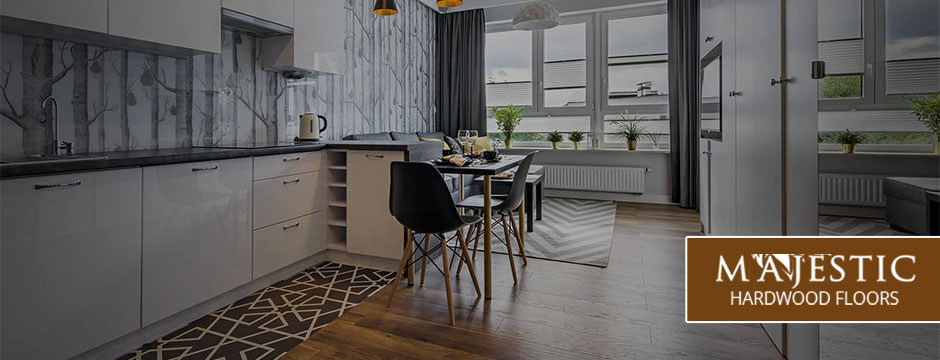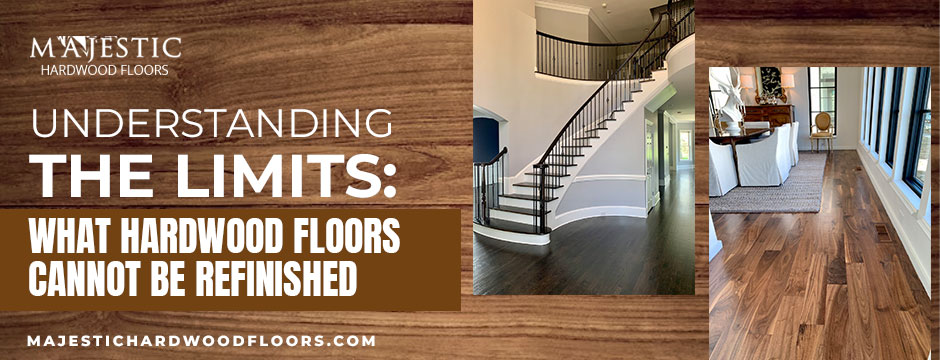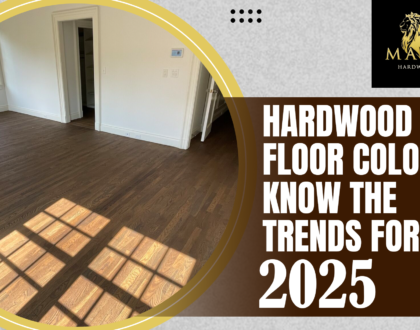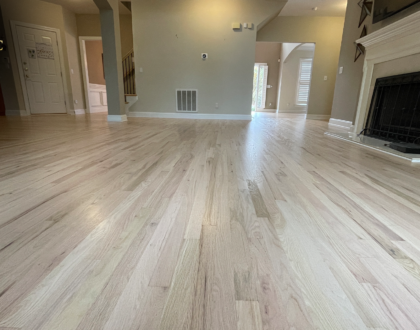Understanding the Limits: What Hardwood Floors Cannot Be Refinished

Hardwood floors are a timeless and elegant choice for home interiors, prized for their durability and natural beauty. However, as with any flooring material, hardwood floors may show signs of wear and tear over time. Many homeowners turn to the process of refinishing to breathe new life into their hardwood floors. In this blog, we will delve into the nuanced world of hardwood floor refinishing, exploring the scenarios where this transformative process may not be a suitable solution.
Understanding Hardwood Refinishing
Before we embark on exploring the constraints of hardwood refinishing, it’s imperative to delve into the intricacies of the refinishing process itself. The art of refinishing hardwood floors is a transformative journey that breathes new life into worn-out surfaces. This meticulous process entails the strategic removal of the existing finish through sanding, addressing imperfections that may have accrued over time, and culminating in the application of a fresh coat of finish. This comprehensive rejuvenation not only enhances the aesthetic allure of the hardwood but also serves as a safeguard, significantly extending the overall lifespan of the flooring.
Factors Influencing Refinishing Potential
Type of Hardwood
In the realm of hardwood refinishing, it becomes evident that not all wood species are created equal. Some, such as the venerable oak and the timeless maple, gracefully undergo the refinishing procedure, emerging with renewed vitality. However, the journey is not as straightforward for exotic or softer wood varieties. These woods may present unique challenges due to their inherent characteristics, requiring a nuanced approach to ensure successful refinishing.
Thickness of the Hardwood
The thickness of hardwood planks emerges as a pivotal factor influencing the potential for successful refinishing. Thicker planks provide a more substantial foundation to work with during the refinishing process, allowing for multiple sessions if necessary. Conversely, thinner hardwood, while initially charming, may possess limitations. The lack of ample material compromises its ability to endure repeated refinishing, imposing constraints on its overall lifespan.
Hardwood Floor Condition and Damage Types
Scratches and Dents
The battle scars of daily life, manifesting as scratches and dents on hardwood floors, often find redemption in the refinishing process. Superficial imperfections yield gracefully to the meticulous sanding and refinishing techniques, restoring the surface to its former glory. However, the narrative changes when facing deeper wounds. Substantial scratches and significant dents may extend beyond the superficial realm, compromising the structural integrity of the hardwood. In such cases, the effectiveness of the refinishing process is diminished, necessitating alternative measures for restoration.
Water Damage
Water, while essential for life, can be a formidable adversary for hardwood floors. Common yet impactful, water damage introduces challenges to the refinishing endeavor. Beyond the visible effects of warping and discoloration, severe water damage can extend to structural impairment. In scenarios where the very core of the hardwood is compromised, the refinishing process becomes ineffective. The profound impact of water on the wood’s integrity necessitates alternative approaches to rectify the damage, underscoring the importance of preventative measures and swift remediation.
Alternatives to Refinishing
In instances where refinishing proves to be impractical or unfeasible, homeowners are presented with a spectrum of alternative solutions to address the wear and tear of hardwood floors. These alternatives are not only pragmatic but also offer avenues for creativity in preserving the aesthetic appeal of the space.
Strategically Placing Area Rugs or Carpets
One practical and aesthetically pleasing alternative to refinishing is the strategic placement of area rugs or carpets. This approach allows homeowners to cover specific areas that may have incurred damage or wear without resorting to a complete refinishing process. Not only does this solution offer a quick fix, but it also introduces an element of design and style, allowing for a seamless integration of functional and decorative elements within the living space.
Partial Replacement of Damaged Sections
For more localized damage, opting for the partial replacement of damaged sections presents an effective and targeted solution. This alternative involves removing and replacing only the portions of the hardwood that are visibly compromised. Skilled craftsmen can seamlessly integrate new sections with the existing flooring, achieving a harmonious look. This approach strikes a balance between restoration and cost-effectiveness, providing homeowners with the opportunity to address specific areas of concern without committing to a full-scale refinishing project.

Complete Replacement of the Flooring
In extreme cases where the overall condition of the hardwood floor is beyond repair or when a significant transformation is desired, the alternative of complete replacement becomes a viable option. This comprehensive approach involves removing the existing flooring and installing an entirely new hardwood surface. While more intensive and costly, complete replacement offers a fresh canvas, allowing homeowners to explore different wood types, finishes, and styles, thereby reinventing the ambiance of the entire space.
Professional Assessment and Consultation
The intricacies involved in hardwood floors and the refinishing process underscore the invaluable role of seeking professional advice. Flooring professionals, armed with expertise and experience, play a pivotal role in guiding homeowners through the decision-making process.
Assessing the Condition of Hardwood Floors
Professionals conduct a thorough assessment of the current condition of the hardwood floors. This assessment takes into account various factors, including the type of wood, its thickness, and the extent of existing damage. By examining these elements, professionals gain a comprehensive understanding of the unique challenges posed by the specific hardwood in question.
Considering Wood Type, Thickness, and Damage
Wood type, thickness, and existing damage are critical determinants in gauging the feasibility of the refinishing process. Flooring professionals leverage their knowledge to advise homeowners on the most suitable course of action. Whether it involves recommending alternatives, such as area rugs or partial replacement, or affirming the viability of refinishing, their insights contribute to informed decision-making.
Conclusion
While hardwood floor refinishing is a transformative process for many, it’s not a one-size-fits-all solution. Understanding the limitations, considering the type and condition of the hardwood, and seeking professional guidance are essential steps in making informed decisions about the care and maintenance of hardwood floors. By embracing this knowledge, homeowners can navigate the world of hardwood flooring with confidence, ensuring the longevity and beauty of their cherished investment.
Recommended Posts

Hardwood floor colors: Know The Trends For 2025
March 12, 2025

